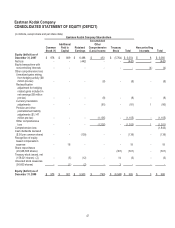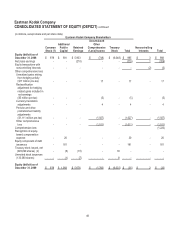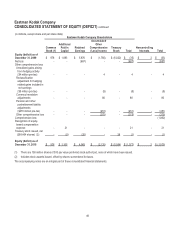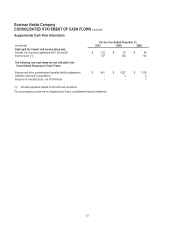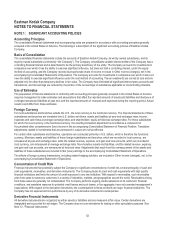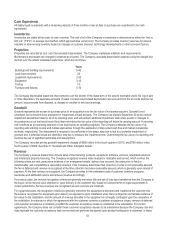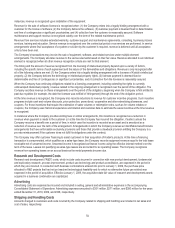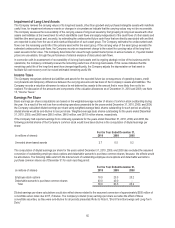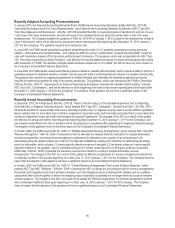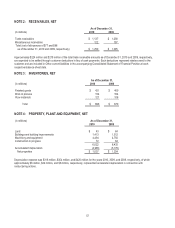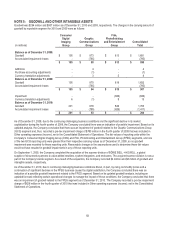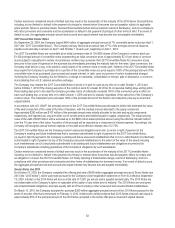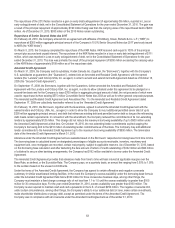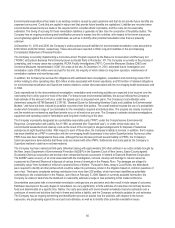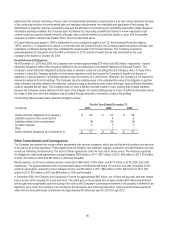Kodak 2010 Annual Report Download - page 58
Download and view the complete annual report
Please find page 58 of the 2010 Kodak annual report below. You can navigate through the pages in the report by either clicking on the pages listed below, or by using the keyword search tool below to find specific information within the annual report.56
Recently Adopted Accounting Pronouncements
In January 2010, the Financial Accounting Standards Board (FASB) issued Accounting Standards Update (ASU) No. 2010-06,
“Improving Disclosures about Fair Value Measurements,” which amends the Accounting Standards Codification (ASC) Topic 820,
“Fair Value Measures and Disclosures.” ASU No. 2010-06 amended the ASC to require disclosure of transfers into and out of Level
1 and Level 2 fair value measurements, and also will require more detailed disclosure about the activity within Level 3 fair value
measurements. The Company adopted the guidance in ASU No. 2010-06 on January 1, 2010, except for the requirements related to
Level 3 disclosures, which will be effective for annual and interim reporting periods beginning after December 15, 2010 (January 1,
2011 for the Company). This guidance requires new disclosures only.
In June 2009, the FASB issued authoritative guidance establishing two levels of U.S. generally accepted accounting principles
(GAAP) – authoritative and nonauthoritative – and making the ASC the source of authoritative, nongovernmental GAAP, except for
rules and interpretive releases of the Securities and Exchange Commission. This guidance, which was incorporated into ASC Topic
105, “Generally Accepted Accounting Principles,” was effective for financial statements issued for interim and annual periods ending
after September 15, 2009. The adoption changed certain disclosure references to U.S. GAAP, but did not have any other impact on
the Company’s Consolidated Financial Statements.
In June 2009, the FASB issued revised authoritative guidance related to variable interest entities, which requires entities to perform a
qualitative analysis to determine whether a variable interest gives the entity a controlling financial interest in a variable interest entity.
The guidance also requires an ongoing reassessment of variable interests and eliminates the quantitative approach previously
required for determining whether an entity is the primary beneficiary. This guidance, which was reissued by the FASB in December
2009 as ASU No. 2009-17, “Improvements to Financial Reporting by Enterprises Involved with Variable Interest Entities,” amends
ASC Topic 810, “Consolidation,” and will be effective as of the beginning of an entity’s first annual reporting period that begins after
November 15, 2009 (January 1, 2010 for the Company). The adoption of this guidance did not have a significant impact on the
Company’s Consolidated Financial Statements.
Recently Issued Accounting Pronouncements
In December 2010, the FASB issued ASU No. 2010-28, “When to Perform Step 2 of the Goodwill Impairment Test for Reporting
Units with Zero or Negative Carrying Amounts”, which amends ASC Topic 350, “Intangibles – Goodwill and Other”. ASU No. 2010-
28 amends the ASC to require entities that have a reporting unit with a zero or negative carrying value to assess whether qualitative
factors indicate that it is more likely than not that an impairment of goodwill exists, and if an entity concludes that it is more likely than
not that an impairment exists, the entity must measure the goodwill impairment. The changes to the ASC as a result of this update
are effective for annual and interim reporting periods beginning after December 15, 2010 (January 1, 2011 for the Company), and
any impairment identified at the time of adoption will be recognized as a cumulative-effect adjustment to beginning retained earnings.
The adoption of this guidance does not have any impact on the Company’s Consolidated Financial Statements.
In October 2009, the FASB issued ASU No. 2009-13, "Multiple-Deliverable Revenue Arrangements," which amends ASC Topic 605,
"Revenue Recognition." ASU No. 2009-13 amends the ASC to eliminate the residual method of allocation for multiple-deliverable
revenue arrangements, and requires that arrangement consideration be allocated at the inception of an arrangement to all
deliverables using the relative selling price method. The ASU also establishes a selling price hierarchy for determining the selling
price of a deliverable, which includes: (1) vendor-specific objective evidence if available, (2) third-party evidence if vendor-specific
objective evidence is not available, and (3) estimated selling price if neither vendor-specific nor third-party evidence is available.
Additionally, ASU No. 2009-13 expands the disclosure requirements related to a vendor's multiple-deliverable revenue
arrangements. The changes to the ASC as a result of this update are effective prospectively for revenue arrangements entered into
or materially modified in fiscal years beginning on or after June 15, 2010 (January 1, 2011 for the Company). The Company does not
expect that the adoption of this guidance will have a significant impact on its Consolidated Financial Statements.
In October 2009, the FASB issued ASU No. 2009-14, "Certain Revenue Arrangements That Include Software Elements," which
amends ASC Topic 985, "Software." ASU No. 2009-14 amends the ASC to change the accounting model for revenue arrangements
that include both tangible products and software elements, such that tangible products containing both software and non-software
components that function together to deliver the tangible product's essential functionality are no longer within the scope of software
revenue guidance. The changes to the ASC as a result of this update are effective prospectively for revenue arrangements entered
into or materially modified in fiscal years beginning on or after June 15, 2010 (January 1, 2011 for the Company). The Company
does not expect that the adoption of this guidance will have a significant impact on its Consolidated Financial Statements.



